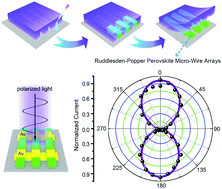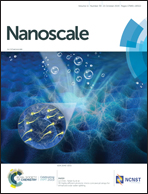Template-confined growth of Ruddlesden–Popper perovskite micro-wire arrays for stable polarized photodetectors†
Abstract
The detection of the polarization states of light is of great significance for the analysis of biological tissue morphologies, image display systems and sensors. Although organic–inorganic hybrid perovskite crystals have excellent photoelectric properties, which make them very suitable for the preparation of photodetectors, their applications in polarized light detection are hindered by their isotropy and instability. Here, we solved this problem by fabricating a stable 2D layered Ruddlesden–Popper perovskite into anisotropic micro-wire arrays with a template-confined method. Based on this anisotropic structure, a high-performance photodetector with a dark current as low as 10−12 A, high responsivity of 3.5 A W−1, detectivity exceeding 1 × 1015 Jones and a fast response with a rise time of 4.1 ms and a decay time of 3.3 ms was achieved and successfully applied for high-performance polarization detection. More importantly, the device maintained a superior performance even after being exposed to an environment of 60% relative humidity without encapsulation.



 Please wait while we load your content...
Please wait while we load your content...